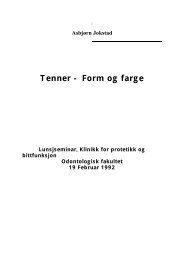Quality of dental restorations. FDI Commission Pro... - ResearchGate
Quality of dental restorations. FDI Commission Pro... - ResearchGate
Quality of dental restorations. FDI Commission Pro... - ResearchGate
Create successful ePaper yourself
Turn your PDF publications into a flip-book with our unique Google optimized e-Paper software.
138study <strong>of</strong> initially 158 fixed prosthesesmade by senior <strong>dental</strong> students25 years previously. The resultsindicated that the frequency <strong>of</strong> pulpdeterioration in association withbridges tends to be related to thesize <strong>of</strong> the prosthesis. It can bespeculated that this can be theeffect <strong>of</strong> biomechanical complexity,including factors such as acomplex alignment <strong>of</strong> preparationswith possible iatrogenic tissueremoval and overtapered abutments;lack <strong>of</strong> acceptable fit in parts<strong>of</strong> the casting; tendency to acceptsmall discrepancies in large, fixedprostheses compared to singlecrowns, and the complications <strong>of</strong>oral hygiene procedures.Periapical complications andvertical root fractures following theplacement <strong>of</strong> <strong>restorations</strong> orcrowns with pulpal or parapulpalposts may be considered as iatrogenic.Cross-sectional studies indicatethat this is perhaps morecommon than is acceptable. Grieveand McAndrew 204 examined radiographically327 post-retained crownsfor length <strong>of</strong> post, length <strong>of</strong>remaining root filling, periapicalcondition, fit and angulation <strong>of</strong>the post and quality <strong>of</strong> root filling.Most root fillings were judged tobe unsatisfactory, and there wasno radiographic evidence <strong>of</strong> anyroot filling in nearly 10 per cent <strong>of</strong>cases.Investigations published before1992 on the possible relationshipbetween Class I and Class II cavitypreparations for amalgam andadverse effects on the pulp hasbeen reported in a previous paper,and will not be discussed further 113 .Material handling andproceduresThe principles for prevention <strong>of</strong>pulpal damage during preparationwith rotating instruments wereoutlined many years ago, and arestill valid today. Key factors arefrictional heat and adequate cooling,excessive dehydration and airblast, and vibration and highspeed 46 .Concerns over possiblemicroleakage and postoperativesensitivity with amalgam <strong>restorations</strong>have led many practitionersto use various varnishes and resincontaininglining, or ‘adhesive’materials. However, others havequestioned the merit <strong>of</strong> amalgambonding, and the results areconflicting 205 .Cases <strong>of</strong> persistent post-operativesensitivity with composite resin<strong>restorations</strong> following total etchingand application <strong>of</strong> some dentineadhesives have been reported. Thisclinical phenomenon can occurdespite careful isolation prior todirect restorative procedures andthe use <strong>of</strong> an incremental build uptechnique, as well as after cementation<strong>of</strong> indirect <strong>restorations</strong> inconjunction with using a compositeresin cement. <strong>Pro</strong>blems regardingpost-operative sensitivity are hypothesisedto be related to a deficientlight-curing source, or incompleteevaporation <strong>of</strong> the primer solventsprior to application <strong>of</strong> the bondingagent. Alternative suggestions aregaps, cracks in enamel related topolymerisation stresses, fracture <strong>of</strong>tooth substance at the restorationcavity interface and polymerisationshrinkage followed by hydraulicforces induced during masticationon the dentinal tubule fluid followingflexure <strong>of</strong> the restoration 195,206 .Patient factorsIntraoral locationIn a study <strong>of</strong> 88 composite resin<strong>restorations</strong> over two years it wasobserved that the postoperativesymptoms were significantly lowerin premolars compared to molars 101 .Borgmeijer et al. 196 reported postoperativesensitivity after placing244 Class II <strong>restorations</strong> <strong>of</strong>composite resin and amalgam. Postoperativesensitivity occurred more<strong>of</strong>ten in the molars than in thepremolars although the differencewas not statistically significant. Theresearch group reported that thisfinding had also been observed inanother study <strong>of</strong> 240 indirect ClassII composite resin inlays and amalgam<strong>restorations</strong> 207 .Age and genderDuring function, secondary andreparative dentine is deposited inthe pulp. At age 55 years, thevolume <strong>of</strong> the pulp is about 20 percent <strong>of</strong> that at age 25, and containsonly 20 per cent <strong>of</strong> the bloodsupply 208 . This suggests that thepulp’s capacity <strong>of</strong> recovery decreaseswith age. However, there are nodata in the literature reporting theincidence <strong>of</strong> endodontic complicationsas a function <strong>of</strong> patient agefollowing restorative therapy.Oral environmentAnecdotal observations suggest thatbruxism may be associated with anincreased risk <strong>of</strong> pulpal complicationsfollowing flexing <strong>of</strong> the<strong>restorations</strong> and gap formation.The clinical evidence for this is poor.In one early in vitro study it wasdemonstrated that composite resin<strong>restorations</strong> placed in third molarsexhibited increased microleakagewhen an antagonist was presentcompared to none 209 . The authorconcluded that bacterial leakagearound <strong>restorations</strong> in cavitiessurrounded by enamel would most<strong>of</strong>ten be the result <strong>of</strong> stress in therestored tooth during occlusion andarticulation. The study has not beenduplicated using modern dentinebonding systems, so it is uncertainto what extent the conclusion isapplicable to newer composite resinmaterials.Does technical excellencepredict failure?A clear relationship between endodonticcomplications and criteriafor technical excellence <strong>of</strong> <strong>dental</strong><strong>restorations</strong> has not been demonstrated.Several review papers havesuggested that such a relationshipexists, but this is substantiatedmostly with laboratory andmicroleakage studies 210 . In one clinicalstudy the radiographic quality<strong>of</strong> the root filling and the appearance<strong>of</strong> the apical one-third <strong>of</strong>International Dental Journal (2001) Vol. 51/No.3



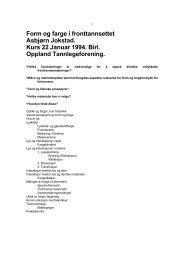
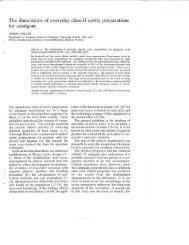
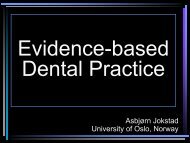
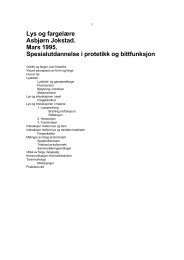

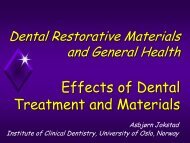
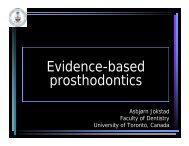

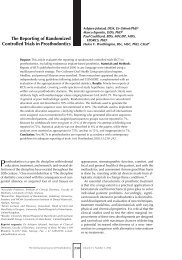
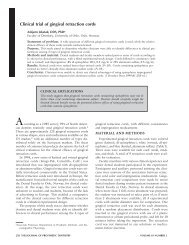

![[Sementer i fast protetikk] Scandinavian Society for Prosthetic](https://img.yumpu.com/18378889/1/190x245/sementer-i-fast-protetikk-scandinavian-society-for-prosthetic.jpg?quality=85)
